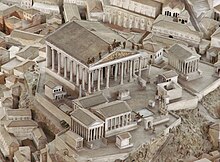Plastico di Roma Antica



The Plastico di Roma antica or Plastico di Roma imperiale is a plastic city model of ancient Rome on a scale of 1: 250, produced under the guidance of the Italian archaeologist and architect Italo Gismondi between 1933 and 1937 and in the light of archaeological discoveries until the early 1970s Years has been updated and is also being updated in the present.
History of origin
The model depicting the city of Rome in the fourth century under Emperor Constantine is an exhibit of the Museo della Civiltà Romana on the EUR ( Esposizione Universale di Roma ).
Even if the model of Gismondi is the largest ever made, it is not the first model of the city of Rome. The models by Giuseppe Marcelliani at the beginning of the 20th century and that by Paul Bigot preceded it. However, it is the one that takes into account the more recent archaeological findings.
The project is also a political project with which Benito Mussolini sought to increase the size of the Roman Empire , which was originally part of fascist politics. This highlighting of the greatness of the Roman Empire and Roman times was also seen in the early works on the topography of Rome in the early 20th century, when the new Italian state emerged as the heir to ancient greatness. It also benefits from the work around the Forma Urbis Romae by Rodolfo Lanciani and other previous projects that have improved knowledge of the topography of ancient Rome.
The model was made by Gismondi and his assistants between 1933 and 1971. It was updated practically until the death of its creator. The Plastico di Roma antica will also be adapted at the beginning of the 21st century.
Web links
- Plastico di Roma imperiale on the website of the Museo della Civiltà Romana
Individual evidence
- ↑ Andrea Felice: Il Plastico di Roma Antica - a Closer look over Rome at the Caesar'stime (April 8, 2017) (English)